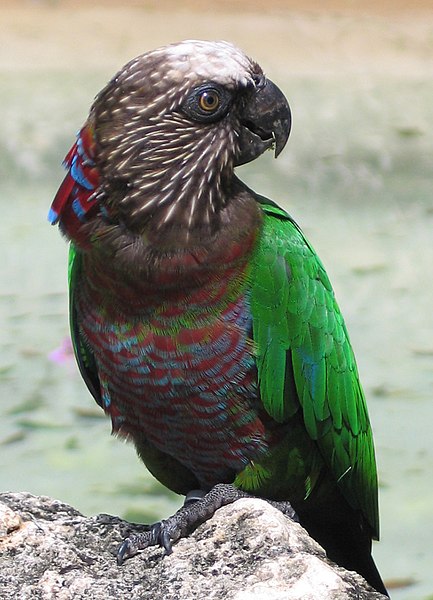 The vibrant colors and unique erectile head crest of the hawk headed or red fan parrot (Deroptyus accipitrinus) have long rendered it a favorite pet in its native South America. After the first exports in the mid 1800’s, the bird achieved instant stardom in zoos and private collections worldwide.
The vibrant colors and unique erectile head crest of the hawk headed or red fan parrot (Deroptyus accipitrinus) have long rendered it a favorite pet in its native South America. After the first exports in the mid 1800’s, the bird achieved instant stardom in zoos and private collections worldwide.
The Unique Crest
The first hawk headed parrot I encountered, a wild caught male at a bird importers decades ago, surprised me in a way that only this bird can – it flashed a head crest of deep red, blue-edged feathers and hissed menacingly. The unexpected display of size and color stopped me in my tracks, as well it might a predator. I was later fortunate enough to glimpse a pair in the wild, and have cared for a number in captivity.
Hawk heads are the only parrots to possess a feather crest that encircles the head. They are the sole members of their genus, and their relationships to other parrots are unclear.
In addition to its role as a threat display, the crest is raised by courting birds as well. Some observers report that displaying birds also glide earthward from above in succession.
The Name – Origin and a Thought
The “hawk headed” part of the name is said to arise from the barred pattern on the head crest, which resembles that of some hawks.
I wonder, however, if the name does not somehow relate back to the magnificent harpy eagle, which shares some of its range. One of the world’s largest birds of prey, the harpy also has a head crest, and features prominently in local lore wherever it occurs.
Physical Description
The rest of this bird’s plumage is no less spectacular than the crest. The back, wings and thighs are a fluorescent green, and the breast and abdomen feathers are dark red edged in bright blue. The blue-edged green tail feathers have distinctly rounded tips.
Range and Habitat
Two subspecies range from Ecuador through southern Columbia, northern Peru and Venezuela to Guyana, and south to northwestern Brazil.
They favor forest edges, and roost in hollow trees rather than on branches as do most other parrots.
Hawk Headed Parrots as Pets
Hawk headed parrots are not all that common in the pet trade, but are well-worth searching for. The smaller subspecies, known as the buff-crowned (D. a. accipitrinus) is more commonly bred than is the southern (Brazilian) subspecies, D. a. fuscifrons.
They are affectionate and talk well. Even more so than many other parrots, individualism is the rule…some bond strongly to one person, others are accepting of most anyone.
Nearly all change drastically when breeding, however, becoming very aggressive towards people and, surprisingly often, towards one another.
Feeding
Fruit forms a significant part of the natural diet, and captives need a wide variety of types if they are to thrive. Tropic Fruit Pudding and freeze dried fruits are a convenient means of providing important dietary variety.
Hawk heads tend to be picky eaters, and may balk at pellets and most seeds. Nutriberries are designed for such situations, and are usually readily accepted (it may help to feed fruit at one meal and only Nutriberries at the other).
Further Reading
An article on the behavior of hawk headed parrots in the wild, published in The Condor, is posted at http://elibrary.unm.edu/sora/Condor/files/issues/v093n01/p0177-p0180.pdf.
Image referenced from Wikipedia and originally posted by Bobby.
 That Bird Blog – Bird Care and History for Pet Birds
That Bird Blog – Bird Care and History for Pet Birds



One comment
Pingback: Website